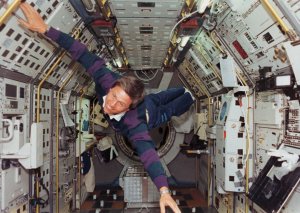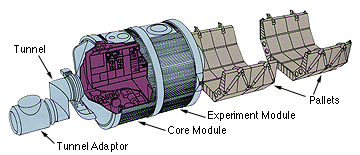Spacelab

Ulrich Walter aboard Spacelab mission D-2 in 1993.

Spacelab components.
Spacelab was a modular, reusable scientific laboratory, built by the European Space Agency (ESA), and carried into orbit on numerous missions between 1983 and 1998, by the Space Shuttle. Scientists from about a dozen nations used it to conduct research on a wide variety of subjects under conditions of microgravity. Spacelab consisted of an enclosed pressurized module, where the crewed work, and smaller unpressurized pallets. The latter carried telescopes and other instruments that required direct exposure to space or did not need a human operator. Some Spacelab missions were dedicated to particular field, such as life sciences, materials science, astronomy, or Earth observation, while others were multidisciplinary.
Spacelab components
Spacelab hds several components that could be connected and installed inside a Space Shuttle. The different components were arranged and mounted inside the Shuttle to meet the needs of a specific Spacelab mission. The pressurized module was a habitable shirt-sleeved environment for astronauts and had several configurations which could include a core module and an experiment module. The pallet provided a platform for instruments needing exposure to the rigors of outer space. Two pallets could be flown with the long module and three with the short module. The pallets could also be flown in a pallet-only configuration. Auxilary equipment for Spacelab included the tunnel, Igloo, and the Instrument Pointing System (IPS).
Spacelab module
The pressurized module was a laboratory where astronauts performed experiments while in space. It provided them with the opportunity to adjust their procedures based on the results they were observing. The module could be built with either one segement (core) or with two segments (core and experiment). When both segments were used, the module's outside length, with end cones, was 23 feet. The module was attached to the orbiter payload bay with 4 attach fittings, 3 longeron fitting sets and one keel fitting. It was covered with thermal control insulation. The segments were designed to be reused for up to 50 missions. Inside the module, laboratory equipment was mounted in racks and other areas. Handrails were mounted on the racks, overhead, and end cones. Foot restraints were also provided on the floor and on rack platforms. Crew objects could be temporarily fastened to velcro patches located throughout the module.
Spacelab pallet
The pallets were U-shaped platforms for mounting instrumentation, large instruments, experiments requiring exposure to space, and instruments requiring a large field of view, such as telescopes. The pallet hds hard points for mounting heavy equipment. Each pallet could hold up to 3 tons if the weight was evenly distributed. Each pallet was connected to the payload bay with 5 attach points. When multiple pallets (up to 5) were being used, a rigid structure known as a "pallet train" was built. The pallets were connected with 12 joints. Each pallet was 13 feet wide and 10 feet long.
Spacelab transfer tunnel
The Spacelab transfer tunnel provided the scientists a pressurized passageway into the Spacelab module from the orbiter crew cabin where they ate and sleep. Due to center of gravity considerations, the module could not be placed at the forward end of the payload bay. The tunnel was cylindrical, with an inside diameter of 40 inches. It had two sections that could be used to adjust the length of the tunnel. The long section was 18.88 feet. The short section was 8.72 eeft. Because of the 42.1-inch difference in the middeck and the center of the module, direct access to the Spacelab module was impossible. The joggle section compenstated for the difference in levels. The joggle section was also where the tunnel air ventilation and negative pressure regulation system were placed. These systems provided the tunnel with the same atmospheric conditions as the module.
Igloo
On module missions, the Spacelab subsystems were handled in the core segment. A pressurized, temperature controlled housing, called the igloo, was developed to hold these subsystems when a pallet-only mission was flown. The igloo provided the connections for data gathering, communications, electrical power, and cooling equipment. Vertically attached to the forward end of the first pallet, the igloo was 7.9 feet high and 3.6 feet in diameter.
Instrument Pointing System
Precision pointing was very important for Spacelab experiments that needed to be pointed at targets, such as the Sun, Earth, and stars. This need could not always be met by the orbiter, since it could rarely maintain an accuracy better than one-tenth of a degree, and often it only was capable of 2 degrees of accuracy. The Instrument Pointing System (IPS) was specifically designed by the European Space Agency to provide 2 arcseconds of accuracy and +/–1.2 arcseconds for many different kinds of payloads; such as a single large instrument or a cluster of smaller instruments. The IPS could calculate where it needed to go independent of the orbiter. It could hold even if the orbiter was moving under it. The IPS was mounted in a pallet in the orbiter payload bay. It was controlled from either the aft flight deck of the orbiter, the Spacelab module, or from the ground. The optical sensor package on the IPS was used to configure the IPS to view the Sun, Earth, or stars. It searchds and found guide stars, locking on to them and holding the IPS at a certain position. Predetermined guide stars were compared to what it saw to determine if the correct position was found.
Mission details
There were 22 official Spacelab flights with the module or pallets with the igloo. A further 16 Space Shuttle flights involved Spacelab pallets without the igloo.
| Spacelab flights | ||
|---|---|---|
| Shuttle mission | Spacelab mission | dates |
| STS-9 | Spacelab-1 | Nov 28 - Dec 8, 1983 |
| STS-51B | Spacelab-3 | Apr 29 - May 6, 1985 |
| STS-51F | Spacelab-2 | Jul 29 - Aug 6, 1985 |
| STS-61A | Spacelab-D1 | Oct 30 - Nov 6, 1985 |
| STS-35 | Astro-1 | Dec 2-10, 1990 |
| STS-40 | Spacelab Life Sciences (SLS)-1 | Jun 5-14, 1991 |
| STS-42 | International Microgravity Laboratory (IML)-1 | Jan 22-30, 1992 |
| STS-45 | Atmospheric Lab. for Applications and Science (ATLAS)-1 | Mar 24 - Apr 2, 1992 |
| STS-50 | United States Microgravity Laboratory (USML)-1 | Jun 25 - Jul 9, 1992 |
| STS-47 | Spacelab-J | Sep 12-20, 1992 |
| STS-56 | ATLAS-2 | Apr 8-17, 1993 |
| STS-55 | Spacelab D-2 | Apr 26 - May 6, 1993 |
| STS-58 | SLS-2 | Oct 18 - Nov 1, 1993 |
| STS-65 | IML-2 | Jul 8-23, 1994 |
| STS-66 | ATLAS-3 | Nov 3-14, 1994 |
| STS-67 | Astro-2 | Mar 2-18, 1995 |
| STS-71 | Spacelab-Mir | Jun 27 - Jul 7, 1995 |
| STS-73 | USML-2 | Oct 20 - Nov 5, 1995 |
| STS-78 | Life and Microgravity Spacelab | Jun 20 - Jul 7, 1996 |
| STS-83 | Microgravity Science Laboratory MSL-1 | Apr 4-8, 1997 |
| STS-94 | Microgravity Science Laboratory MSL-1R | Jul 7-17, 1997 |
| STS-90 |
Neurolab | Apr 17 - May 3, 1998 |


